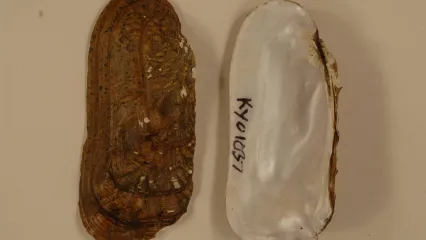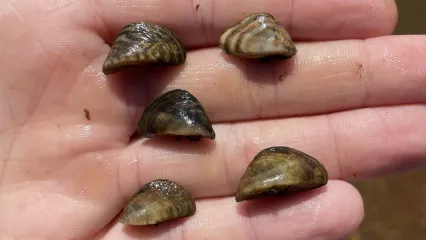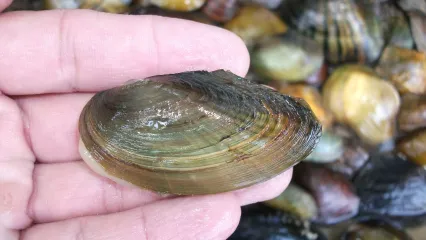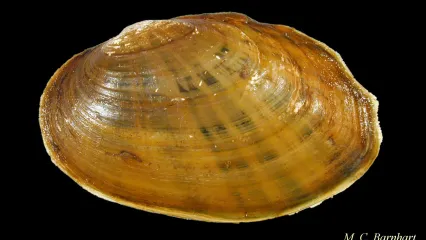
Description
The rabbitsfoot is a freshwater clam with an elongate shell approximately 4-6 inches in length. Its color can vary from dark brown to light green. Multiple knobs are often evident on the shell of the rabbitsfoot, a characteristic that may allude to its namesake.
As with other mussels, the primary cause of population declines of the rabbitsfoot is the construction of reservoirs and impoundments throughout its range. Direct disturbance by human recreational activities also can have a negative impact on rabitsfoots. Other threats to the rabbitsfoot include river channelization, point- and non-point source pollution, sedimentation and agricultural runoff.Biologists from the U.S. Fish and Wildlife Service and Missouri State University are researching effective ways to propagate and raise rabbitsfoots in captivity for release at various sites to augment wild populations. Female rabbitsfoots with fertilized eggs are temporarily removed from the wild and allowed to inoculate host fish in the laboratory. Once developed, young mussels will be raised to a certain size and then released. Rabbitsfoot also have been collected in Oklahoma’s Verdigris River to help reestablish mussel populations further upstream in Kansas. A segment of the Little River runs through the Little River National Wildlife Refuge, near Idabel, and is managed by the U.S. Fish and Wildlife Service. As a result, many important mussel beds containing rabbitsfoot are protected.
Size
4-6 inches in length.
Habitat
Rabbitsfoot mussels tend to select areas with sandy or gravel bottoms, often in side-channels with slower flow near the shore. The rabbitsfoot was historically found in the Verdigris, Neosho, Spring, Illinois, Blue and Littlerivers in Oklahoma. Populations currently remain in the Verdigris, Illinois, and Little rivers. While rabbitsfoots still exist in the Spring and Neosho rivers, they are considered very rare or extirpated in the Oklahoma portion. Due to modification of the Verdigris River from construction of Oologah Reservoir and the McClellan-Kerr Navigation System, rabbitsfoot populations in that river have become reduced and isolated due to inundation of formerly-occupied habitat.
Life Cycle
The rabbitsfoot feeds by filtering out microscopic organisms and organic particles from the water column. As with many other mussels, it has a complex life cycle and requires the use of certain fish species as hosts for its larvae. After eggs are fertilized in the summer, they develop into mussel larvae, called glochidia. Using an organ called a mantle, female rabbitsfoot mussels will lure in host fish by tricking them into believing that they are a prey item. When the host fish, usually a shiner (Cyprinella sp.) attacks the “lure”, many glochidia are released and attach themselves to the gills of the fish. After several days, the glochidia transform into young mussels and drop into the substrate of the river, where they mature into adults. Adult rabbitsfoots occasionally move during certain periods throughout the year, usually in response to seasonal changes.


